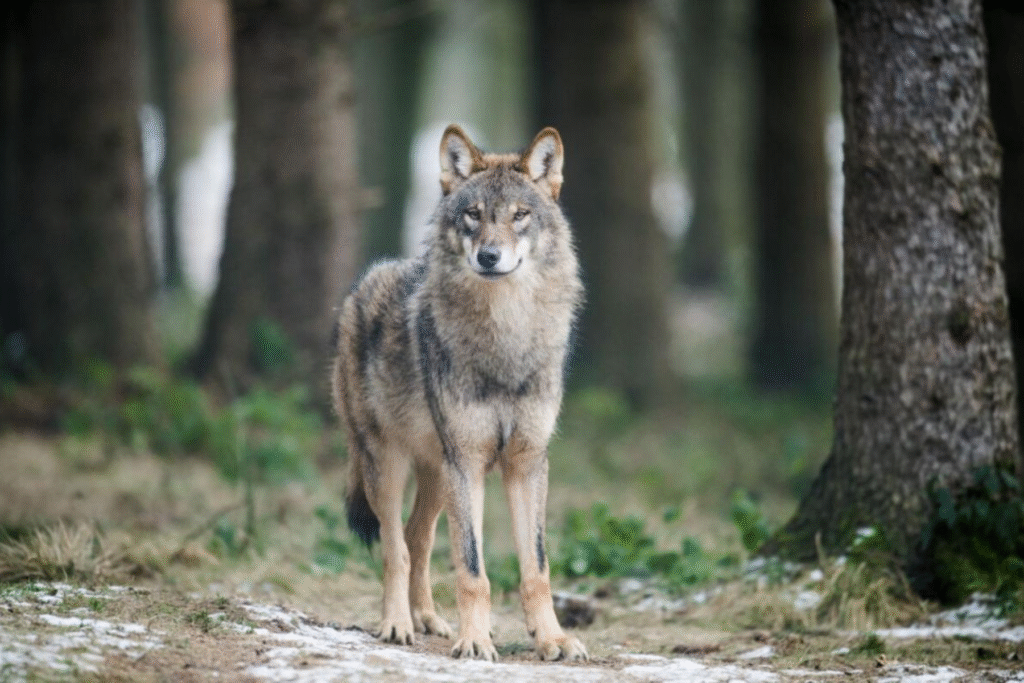
The topic of wolves continues to spark debate. While some want to preserve the predator’s habitat, others worry about the safety of people and livestock. To learn more about the native wolf, the University of Natural Resources and Life Sciences in Vienna (BOKU) conducted, on behalf of the Ministry of Agriculture, the first-ever study assessing the wolf’s conflict potential in Austria. The western and southern parts of the country are particularly affected.
There are 21,000 wolves in Europe, and the population has increased significantly in recent years after the species had once been threatened with extinction. As a result, there have been repeated attacks on livestock, and wolves have been appearing in populated areas, leading to growing conflict potential.
The public has perceived this as a safety risk, said Agriculture Minister Norbert Totschnig (ÖVP) on Wednesday at a press conference in Vienna. “For us, it was clear that in light of this development, it is necessary to maintain the balance in our natural and cultural landscape and ensure that the wolf retains its natural fear of humans.” In early October, a wolf in the Zwettl district of Lower Austria was shot after attacking, injuring, and killing livestock.
Study launched in April 2024
The BOKU study “LeKoWolf: Habitat and Conflict Potential Model for the Wolf (Canis lupus) in Austria” began in April of last year. It aimed to answer questions such as which habitats in Austria are ecologically suitable for wolves, where socio-economic conflict potential with wolves arises, and which areas are most affected by both habitat and conflict factors. These models are intended to provide a data-driven foundation for effective wolf management that can balance the wolf’s protected status under the EU Habitats Directive with the interests of affected communities.
The study shows that Austria theoretically has potential habitats for wolves — particularly in alpine regions — said Totschnig. However, these same regions also carry conflict potential due to livestock farming, alpine grazing, and tourism. Using detailed maps, areas with high to low conflict potential were identified for the first time, Totschnig added.
Predators widespread in Europe
The study showed that wolves are widespread across Europe. Animals can migrate into Austria from all directions, said study author Jennifer Hatlauf from BOKU’s Institute of Wildlife Biology and Game Management. “Even if all wolves disappeared today, new ones would arrive tomorrow.” This is due to rising populations in neighboring countries and the species’ natural dispersal behavior. “A young wolf in search of a mate will travel long distances,” Hatlauf explained. After wolves were eradicated in Austria in the mid-19th century, the first pack reappeared in 2016. By 2024, there were already nine packs, and in 2025 there have so far been eight confirmed packs in Austria.
In 2023, there were over 100 wolf detections; in 2024, fewer than 100. Accordingly, wolf-related damages have also decreased following a peak in 2022, the researcher noted. Models on habitat, livestock attacks, and conflict potential were developed, identifying hot spots mainly in western and southern Austria. Hatlauf called the analysis “groundbreaking and valuable.”
Basis for future conflict solutions
The findings are expected to inform future conflict resolution and management measures. The study is “an important building block toward a functional and scientifically sound wolf management system in Austria,” said Totschnig. It also revealed a need for further research. Therefore, the Ministry, together with the federal states, will commission another study to determine the criteria for a “favorable conservation status” of wolves in Austria.
Active wolf monitoring planned
Preparations are currently underway to align national legislation with the revised EU legal framework. This includes establishing an active wolf monitoring program to record Austria’s wolf population and determining a favorable conservation status as a prerequisite for active wolf management. “We are now creating the scientific foundation,” said Totschnig. The completed study only covers one part of the broader topic.
The issue of wolves is highly emotional, said Tyrolean Deputy Governor Josef Geisler (ÖVP). “Urban people in cities are less affected than those in rural or mountainous regions.” When conflicts with large predators occur within 50 kilometers, opposition increases significantly, Geisler noted. “That’s why it’s important to replace ideology with pragmatism and let science speak.”
Debate over livestock protection
During the press conference, the minister also addressed livestock protection, which is often presented as the only viable solution. However, experiences from other EU countries show otherwise. “Ultimately, we must recognize that without regulating wolf populations, it simply doesn’t work in practice,” said Totschnig. Geisler also emphasized that livestock protection involves “a very high organizational effort.” In the past, sheep could roam freely in alpine pastures, “but now, with herd protection, they have to be fenced in,” he said. This only works if the animals are in good health; otherwise, there is a high risk of spreading various diseases. Veterinary care must therefore begin in winter to ensure the animals are in good condition by the start of the grazing season.
On the occasion of the study’s presentation, the animal protection organization WWF once again called for a nationwide herd protection campaign. Shooting wolves is not a sustainable solution, it said in a statement. The campaign would support livestock owners in hiring shepherds and acquiring guard dogs and electric fences. Such measures have proven effective, as shown in comparable alpine regions like Switzerland, where the number of livestock killed per wolf has dropped by 87 percent, said WWF spokesperson Leonhard Steinmann.
According to the WWF, shooting remains the most common cause of death for wolves in Austria. In 2024 alone, 13 wolves were killed. By comparison, in Germany only two wolves were shot in 2024 — even though Germany, with 209 packs and 46 pairs, has roughly 30 times more wolves with established territories than Austria, the organization noted.

